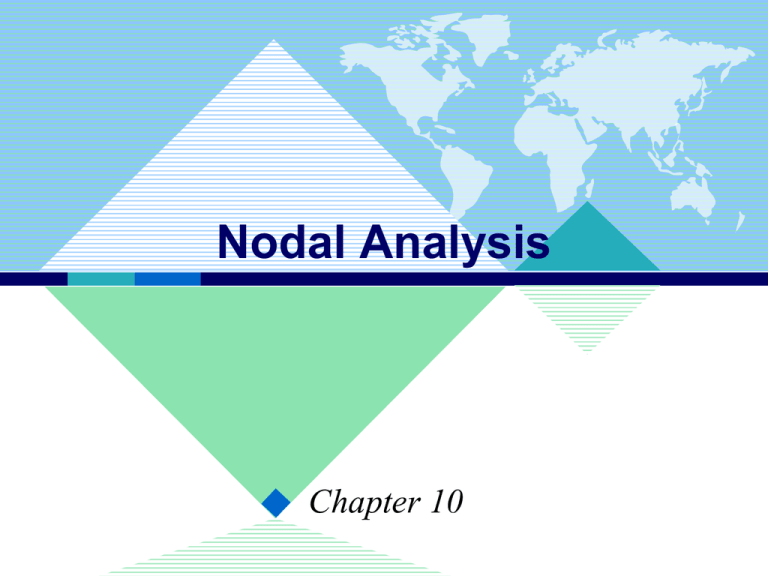Nodal Analysis
advertisement

Nodal Analysis Chapter 10 10.1 Introduction • Step to Analyze AC Circuits: 1. Transform the circuit to the phasor or frequency domain. 2. Solve the problem using circuit techniques (nodal analysis, mesh analysis, superposition, etc.). 3. Transform the resulting phasor to the time domain. ch10_Nodal Analysis 2 10.2 Nodal Analysis Example 10.1 • Find ix in the circuit of Fig. 10.1 using nodal analysis. ch10_Nodal Analysis 3 Fig 10.2 ch10_Nodal Analysis 4 Example 10.1 V1 V1 V2 • At node 1, 20 V1 10 j 2.5 j4 or (1 j1.5)V1 j 2.5V2 20 • At node 2, V1 V2 V2 2I x j4 j2 2V1 V1 V2 V2 I x V1 / j 2.5, j 2.5 j4 j2 we get 11V1 15V2 0 ch10_Nodal Analysis 5 Example 10.1 1 j 2.5 j 2.5 V1 20 11 15 V2 0 1 j 2. 5 j 2. 5 15 j 5 11 15 1 20 j 2.5 0 15 300, 2 1 j 2.5 20 11 0 220 1 300 V1 18.9718.43 V 15 j 5 2 220 V2 13.91198.3 V 15 j 5 ch10_Nodal Analysis 6 Example 10.1 • The current Ix is given by V1 18.9718.43 Ix 7.59108.4 A j 2.5 2.5 90 • Transforming this to the time domain, ix 7.59 cos(4t 108.4) A ch10_Nodal Analysis 7 Example 10.2 • Compute V1 and V2 in the circuit of Fig. 10.4. ch10_Nodal Analysis 8 Example 10.2 • By node 1 and 2, ch10_Nodal Analysis V1 V2 V2 3 j 3 j 6 12 or 36 j 4V1 (1 j 2)V2 9 Example 10.2 • But a voltage source is connected between nodes 1 and 2, so that V1 V2 1045 substituting, 36 40135 (1 j 2)V2 V2 31.41 87.18 V so, V1 V2 1045 25.87 70.48 V ch10_Nodal Analysis 10 10.3 Mesh Analysis Example 10.3 • Determine current Io in the circuit of Fig. 10.7 using mesh analysis. ch10_Nodal Analysis 11 Example 10.3 • Applying KVL to mesh 1, (8 j10 j 2)I1 ( j 2)I 2 j10I3 0 • For mesh 2, (4 j 2 j 2)I 2 ( j 2)I1 ( j 2)I3 2090 0 • For mesh 3, I3 = 5, we get (8 j8)I1 j 2I 2 j 50 j 2I1 (4 j 4)I 2 j 20 j10 • Put it in matrix form as j 2 I1 j 50 8 j8 j2 I 4 j 4 j 30 2 ch10_Nodal Analysis 12 Example 10.3 • We obtain the determinants 8 j8 j2 32(1 j )(1 j ) 4 68 j2 4 j4 2 8 j8 j 50 j2 j 30 340 j 240 416.17 35.22 2 416.1735.22 I2 6.12 35.22 V 68 • The desired current is I o I 2 6.12144.78 A ch10_Nodal Analysis 13 Example 10.4 • Solve for Vo in the circuit of Fig. 10.9 using mesh analysis. ch10_Nodal Analysis 14 Example 10.4 For mesh 1, KVL gives 10 (8 j 2)I1 ( j 2)I 2 8I 3 0 or (8 j 2)I1 j 2I 2 8I 3 10 For mesh 2, I 2 3 For the supermesh, (8 j 4)I3 8I 2 (6 j5)I 4 j5I 2 0 Due to the current source between meshes 3 and 4, at node A, I 4 I3 4 ch10_Nodal Analysis 15 Example 10.4 ch10_Nodal Analysis 16 Example 10.4 (8 j 2)I1 8I 3 10 j 6 8I1 (14 j )I 3 24 j 35 8 I1 10 j 6 8 j 2 I 8 14 j 24 j 35 3 we obtain the following determinan ts 8 j2 8 8 14 j 1 10 j 6 112 j8 j 28 2 64 50 j 20 8 24 j 35 14 j 140 j10 j84 6 192 j 280 58 j186 ch10_Nodal Analysis 17 Example 10.4 • Current I1 is obtained as 1 58 j186 I1 3.618274.5 A 50 j 20 • The required voltage Vo is Vo j 2(I1 I 2 ) j 2(3.618274.5 3) 7.2134 j 6.568 9.756222.32 V ch10_Nodal Analysis 18 10.4 Superposition Theorem Example 10.6 • Find vo of the circuit of Fig. 10.13 using the superposition theorem. ch10_Nodal Analysis 19 Example 10.6 • We let vo v1 v2 v3 • By voltage division, 1 v1 (5) 1 V 1 4 ch10_Nodal Analysis 20 Example 10.6 10 cos 2t 100, 2 red/s 2H 0.1 F jL j 4 1 j5 jL • Let j5 4 Z j5 4 2.439 j1.951 4 j5 • By division, 1 10 V2 (100) 2.498 30.79 1 j4 Z 3.439 j 2.049 v2 2.498 cos( 2t 30.79) ch10_Nodal Analysis 21 Example 10.6 2 sin 5t 2 90, 5 rad/s 2 H 0.1 F jL j10 1 j2 jL • Let j2 4 Z1 j 2 4 0.8 j1.6 4 j2 • By current division, j10 I1 (2 90) A j10 1 Z1 j10 V3 I1 1 ( j 2) 2.32880 V 1.8 j8.4 ch10_Nodal Analysis 22 Example 10.6 • In the time domain, v3 2.33 cos(5t 80) 2.33 sin(5t 10) V v0 (t ) 1 2.498 cos( 2t 30.79) 2.33 sin(5t 10)V ch10_Nodal Analysis 23 10.5 Source Transformation Vs Z s I s ch10_Nodal Analysis Vs Is Zs 24 Example 10.7 • Calculus Vx in the circuit of Fig. 10.17 using the method of source transformation. ch10_Nodal Analysis 25 Example 10.7 20 90 Is 4 90 j 4 A 5 5(3 j 4) Z1 2.5 j1.25 8 j4 Vs I 2 Z1 j 4(2.5 j1.25) 5 j10 V Vx ch10_Nodal Analysis 10 (5 j10) 2.519 28 V 10 2.5 j1.25 4 j13 26 10.6 Thevenin and Norton Equivalent Circuits VTH Z N I N , Z TH Z N ch10_Nodal Analysis 27 Example 10.8 • Obtain the Thevenin equivalent at terminals a-b of the circuit in Fig. 10.22. ch10_Nodal Analysis 28 Example 10.8 j6 8 Z1 j 6 8 2.88 j 3.84 8 j6 j12 4 Z 2 4 j12 3.6 j1.2 4 j12 ZTH Z1 Z 2 6.48 j 2.64 12075 12075 I1 A, I 2 A 8 j6 4 j12 VTH 4I 2 ( j 6)I1 0 ch10_Nodal Analysis 29 Example 10.8 VTH 48075 720(75 90) 4I 2 j 6I1 4 j12 8 j6 37.953.43 72201.87 28.936 j 24.55 37.95220.31 V ch10_Nodal Analysis 30 Example 10.9 • Find the Thevenin equivalent of the circuit in Fig. 10.25 as seen from terminals a-b. ch10_Nodal Analysis 31 Example 10.9 • From KVL at node 1, 15 I o 0.5 o I o 10 A I o (2 j 4) 0.5I o (4 j 3) VTH 0 or VTH 10(2 j 4) 5(4 j 3) j 55 Thus, VTH 55 90 V ch10_Nodal Analysis 32 10.7 Op Amp AC circuits 1. No current enters either of its input terminals. 2. The voltage across its input terminals is zero. ch10_Nodal Analysis 33 Example 10.11 • Determine v0(t) for the o amp circuit in Fig. 10.31(a) if vs = 3 cos 1000t V. ch10_Nodal Analysis 34 Example 10.11 Vs 30, 1000 rad/s • Apply KCL at node 1, 30 V1 V1 V1 0 V1 Vo 10 j5 10 20 or 6 (5 j 4)V1 Vo • At node 2, V1 0 0 Vo 10 j10 V1 jVo ch10_Nodal Analysis 35 Example 10.11 6 j (5 j 4)Vo Vo (3 j 5)Vo 6 Vo 1.02959.04 3 j5 • Hence, vo (t ) 1.029 cos(1000t 59.04) V ch10_Nodal Analysis 36 10.9 Applications • 10.9.1 Capacitance Multiplier Fig. 10.41 ch10_Nodal Analysis 37 Vi Vo Ii jC (Vi Vo ) 1 / jC Vi 0 0 Vo R2 or Vo Vi R1 R2 R1 R2 R2 Ii I i jC 1 Vi or j 1 C Vi R1 R1 Vi 1 Zi Ii jCeq ch10_Nodal Analysis R2 where Ceq 1 C R1 38




